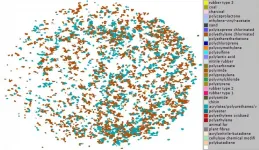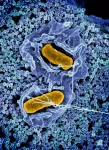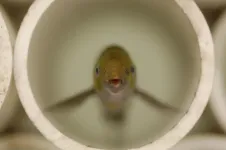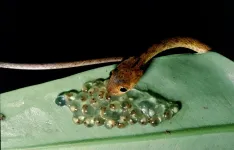Stormwater could be a large source of microplastics and rubber fragments to waterways
2021-05-26
(Press-News.org) In cities, heavy rains wash away the gunk collecting on sidewalks and roads, picking up all kinds of debris. However, the amount of microplastic pollution swept away by this runoff is currently unknown. Now, researchers in ACS ES&T Water report that stormwater can be a large source of microplastics and rubber fragments to water bodies and, with a proof-of-concept experiment, show that a rain garden could keep these microscopic pieces out of a storm drain.
Most cities' storm drains end up discharging directly into wetlands, creeks or rivers. Rainwater running into these drains becomes a concoction of whatever is on the ground, including dirt and grass clippings, leaked car fluids, fertilizer and garbage. Recently, researchers also found that strong rains can displace microplastics, sweeping them into stormwater, but the importance of this runoff as a source of contamination is not well understood. So, Chelsea Rochman and colleagues wanted to see whether microplastics and other tiny particles are carried into waterways by storms in urban areas, and whether a rain garden could prevent that from happening.
The researchers collected water during heavy rainstorms from 12 streams flowing into the San Francisco Bay. First, they separated floating microparticles -- which they define as less than 5 mm in size -- by color and shape and tallied them, finding higher concentrations in the streams than previous researchers had found in treated wastewater that was discharged into the bay. Microscopic fibers and black rubbery fragments were the most common microparticles, while natural debris, glass, paint and wool were only minor components. Then, the team identified a subset of plastic- or rubbery-looking fragments as being made mostly of plastic polymers or other synthetic materials, and many of the black rubbery particles originated from tires. Finally, the researchers compared the microparticles entering a rain garden to those at the garden's outflow into a storm drain. Their results showed that the rain garden captured 91 to 98% of the microparticles and 100% of the black rubbery fragments during three rain events. The researchers say that while rain gardens are known to reduce the amount of metals, nutrients and other pollutants in stormwater runoff, this study shows rain gardens could also be effective at reducing microplastic pollution.
INFORMATION:
The authors acknowledge funding from the Gordon and Betty Moore Foundation, the California Department of Water Resources, the San Francisco Estuary Partnership, the University of Toronto's Research Opportunities Program and the Natural Sciences and Engineering Research Council of Canada.
The paper is freely available as an ACS AuthorChoice article here.
The American Chemical Society (ACS) is a nonprofit organization chartered by the U.S. Congress. ACS' mission is to advance the broader chemistry enterprise and its practitioners for the benefit of Earth and all its people. The Society is a global leader in promoting excellence in science education and providing access to chemistry-related information and research through its multiple research solutions, peer-reviewed journals, scientific conferences, eBooks and weekly news periodical Chemical & Engineering News. ACS journals are among the most cited, most trusted and most read within the scientific literature; however, ACS itself does not conduct chemical research. As a leader in scientific information solutions, its CAS division partners with global innovators to accelerate breakthroughs by curating, connecting and analyzing the world's scientific knowledge. ACS' main offices are in Washington, D.C., and Columbus, Ohio.
To automatically receive news releases from the American Chemical Society, contact newsroom@acs.org.
Follow us: Twitter | Facebook
ELSE PRESS RELEASES FROM THIS DATE:
2021-05-26
Scientists have got up close and personal with human sewage to determine how best to measure hidden and potentially dangerous plastics.
As the way microplastics are measured and counted varies from place to place, there is no agreed understanding of the weight of the problem. Until scientists can agree on one way of measuring them, life on land and sea will continue to ingest who knows how much plastic, affecting health for generations.
A new study, published today in Analytical and Bioanalytical Chemistry, by the University of Portsmouth has examined one method, using a chemical solution called 'Fenton reagent' to ...
2021-05-26
WHAT:
The immune system's attempt to eliminate Salmonella bacteria from the gastrointestinal (GI) tract instead facilitates colonization of the intestinal tract and fecal shedding, according to National Institutes of Health scientists. The study, published in Cell Host & Microbe, was conducted by National Institute of Allergy and Infectious Diseases (NIAID) scientists at Rocky Mountain Laboratories in Hamilton, Montana.
Salmonella Typhimurium bacteria (hereafter Salmonella) live in the gut and often cause gastroenteritis in people. The Centers for Disease Control and Prevention estimates Salmonella bacteria cause about ...
2021-05-26
The COVID-19 pandemic has seen scientists perform incredible feats in a short amount of time, from developing tests to new types of vaccines. Despite these victories, experts are still working to develop an effective antiviral drug to kill the SARS-CoV-2 virus. A cover story in Chemical & Engineering News, the weekly newsmagazine of the American Chemical Society, details the challenges of and progress toward creating a drug that would help the world conquer COVID-19.
Creating a new antiviral drug is a tricky business. Viruses mutate and replicate quickly, and their structures differ greatly even within the same class, ...
2021-05-26
American writer and humorist Mark Twain, a master of language and noted lecturer, once offered, "The right word may be effective, but no word was ever as effective as a rightly timed pause."
Electric fish and today's TED talk speakers take a page from Twain's playbook. They pause before sharing something particularly meaningful. Pauses also prime the sensory systems to receive new and important information, according to research from Washington University in St. Louis.
"There is an increased response in listeners to words -- or in this case, electrical pulses ...
2021-05-26
It's well known that reptiles depend on temperature cues while in the egg to determine a hatchling's sex. Now, researchers writing in the journal Trends in Ecology & Evolution on May 26 say that embryos of many different animal species also rely on acoustic signals in important ways. They call this phenomenon "acoustic developmental programming."
"Acoustic developmental programming occurs when a sound informs embryos about the environment they'll encounter postnatally and changes their development to better suit this environment," said Mylene Mariette (@MyleneMariette) of Deakin University in Australia.
Because this is a newly discovered phenomenon, the evidence is just beginning to accumulate. And, yet, it seems to ...
2021-05-26
Skokie, IL - The International Society for Stem Cell Research (ISSCR), today released updated guidelines for stem cell research and its translation to medicine. The update reflects emerging advances including, stem cell-based embryo models, human embryo research, chimeras, organoids, and genome editing.
"The 2021 update presents practical advice for oversight of research posing unique scientific and ethical issues for researchers and the public," said Robin Lovell-Badge, PhD, FRS, Chair, ISSCR Guidelines task force and Senior Group Leader and Head of the Division of Stem Cell Biology and Developmental Genetics at The Francis Crick Institute, UK. "They provide confidence to researchers, clinicians, and the public ...
2021-05-26
The multifunctional porous solids with diverse functionalized linkers have been utilized as promising materials for various applications in energy, environmental and biomedical areas. Although their emerging properties are ascribed to varying pore types resulting from combinations of functional groups, the chemical environment of the pores remains an open question. A new synthetic platform where the population of pores can be identified and further controlled is of great interest in materials science.
A research team, led by Professor Wonyoung Choe and Professor Tae-Hyuk Kwon in Department of Chemistry ...
2021-05-26
Communities benefit from sharing knowledge and experience among their members. Following a similar principle - called "swarm learning" - an international research team has trained artificial intelligence algorithms to detect blood cancer, lung diseases and COVID-19 in data stored in a decentralized fashion. This approach has advantage over conventional methods since it inherently provides privacy preservation technologies, which facilitates cross-site analysis of scientific data. Swarm learning could thus significantly promote and accelerate collaboration and information exchange in research, especially in the field of medicine. Experts from the DZNE, the University of Bonn, the information technology company Hewlett Packard Enterprise (HPE) and other research institutions report on ...
2021-05-26
New research published in Nature provides a powerful yet surprisingly simple way to determine the number of visitors to any location in a city.
Scientists* from the Santa Fe Institute, MIT, and ETH Zürich have discovered and developed a scaling law that governs the number of visitors to any location based on how far they are traveling and how often they are visiting. The visitation law opens up unprecedented possibilities for accurately predicting flows between locations, which could ultimately have applications in everything from city planning to preventing the spread of the next major pandemic.
"Imagine you are standing on a busy plaza, say in Boston, and you see people coming and going. This ...
2021-05-26
What The Study Did: This study included data from more than 11,000 emergency medical services (EMS) agencies in 49 states to describe racial/ethnic, social and geographic changes in EMS-observed overdose-associated cardiac arrests during the COVID-19 pandemic through 2020 in the United States.
Authors: Joseph Friedman, M.P.H., of the University of California, Los Angeles, is the corresponding author.
To access the embargoed study: Visit our For The Media website at this link https://media.jamanetwork.com/
(10.1001/jamapsychiatry.2021.0967)
Editor's Note: The article includes funding/support disclosures. Please see the article for additional information, including other authors, author ...
LAST 30 PRESS RELEASES:
[Press-News.org] Stormwater could be a large source of microplastics and rubber fragments to waterways




